Sand Valley Golf Course, WI, USA
by
Max Prokopy
August 2022
Thanks in large part to this site’s authors, contributors, and golf lovers worldwide, it is widely recognized that sandy soil, a bit of wind, and fine grasses promote ideal golfing conditions. Challenging the best while fun for all, “firm, fast and true” is so often worth the journey. Here I hope to expound on one of the most appealing sites I’ve ever had the privilege of exploring: Sand Valley. The resort and its course designs can aptly be described as vast.
The property encompasses roughly 12,000 acres. Somehow, it feels even bigger than that. Towering dunes, massive playing corridors, shallow pine trees, a big midwestern sky, and native grasses stick in the player’s mind long after a visit. At the risk of appearing to be an advertisement for the property, this author found getting to and around the resort easier than the must-visit Bandon Dunes.
This review will focus on the eponymous 18-hole Coore/Crenshaw endeavor. The superb adventure of David MacLay Kidd’s Mammoth Dunes and the wildly entertaining par-3 Sandbox are simply not to be missed. The combination of these three options, with limited lodging and a sparse local population lend the resort a distinctive laid-back feel. Perhaps it’s the massive fairways, long views, or expertly run resort operations, but this is a place where things never feel rushed, and you just want to keep playing.
The site is so expansive; it is littered with a seemingly endless number of potential greensites or playing corridors. Like a Renaissance painter with a completely blank canvas, the infinite options afforded by such a site must have required wisdom and attention to truly flourish. Settling on a routing that is sensible, challenging, and amicable to many types of players was seemingly the big challenge. On to the meat of the issue: how do things stack up in the attempt to check all the boxes on this herculean property?
Yardages listed are from the orange tees: playing about 6550, one up from the tips, which 80%+ of male golfers appeared to be playing. The journey begins perched atop the property, allowing the golfer to simultaneously absorb the expanse while realizing wind will almost certainly be a factor in the day’s play. My visit saw sunny skies and winds in the 20-30 mph range.
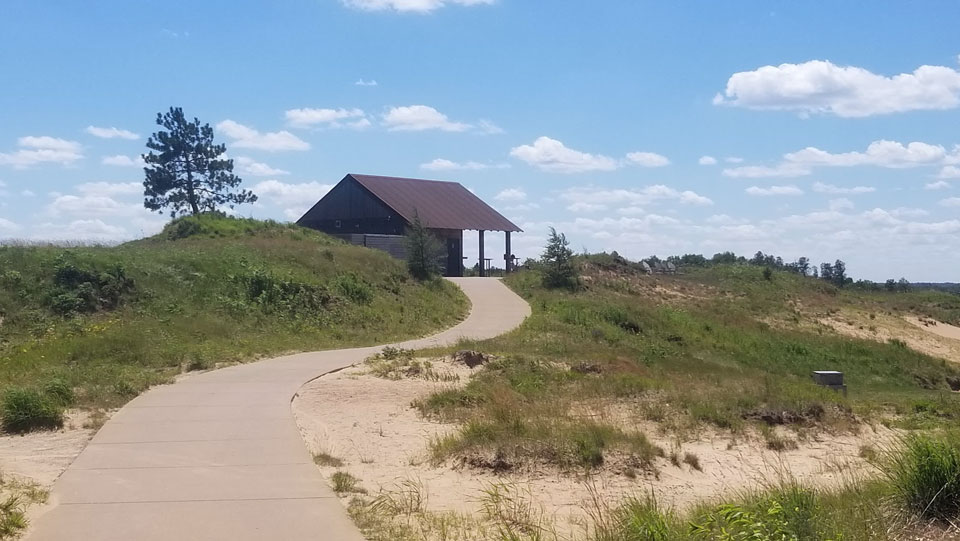
The refreshment hut and warm-up area for the Sand Valley course intimates all the wonders on offer at this Wisconsin golfing haven.
1st Hole: 325 yards, Par 4
A generous starting hole that kindly faces the same wind direction as the nearby warm-up range, this par 4 flows right to left around a sandy expanse. As with many holes on the property, the golfer can take a tight angle but is also allowed a generous bailout. In general, the angle of the green rewards a player for challenging the sand off the tee. The green’s bold interior contours steal the show, allowing for knobby and gathering pin locations depending on the day’s conditions.
2nd Hole: 395 yards, Par 4
Playing longer than the scorecard, this uphill par 4 is one of the few holes at Sand Valley that tack left-to-right. Missing one’s approach right is a probable bogey or worse.
3rd Hole: 192 yards, Par 3
The green is defended by an expanse of sand front/left. Right of the green, where a golfer’s eye might tend to wander, is a large bank that can funnel balls towards the hole. However, missing the right of that bank will leave one with a very challenging up and in. The green is large and has a substantial right-to-left tilt.

As seen from behind the 3rd green, the bailout right appears quite appealing from the tee. The demanding slopes, firm turf, and windy site will likely make for a challenging par.
4th Hole: 557 yards, Par 5
In terms of terrain and strategy, I feel as though the 4th is where things really get going. This uphill par 5 gives the player plenty of room off the tee. Comporting with many admirable designs, the screws tighten as the golfer gets closer to the hole. An uphill/downwind approach to a green with a false front and troublesome back bunker allows for a wide range of scores, which is exactly what a golf-obsessed resort should hope to deliver.
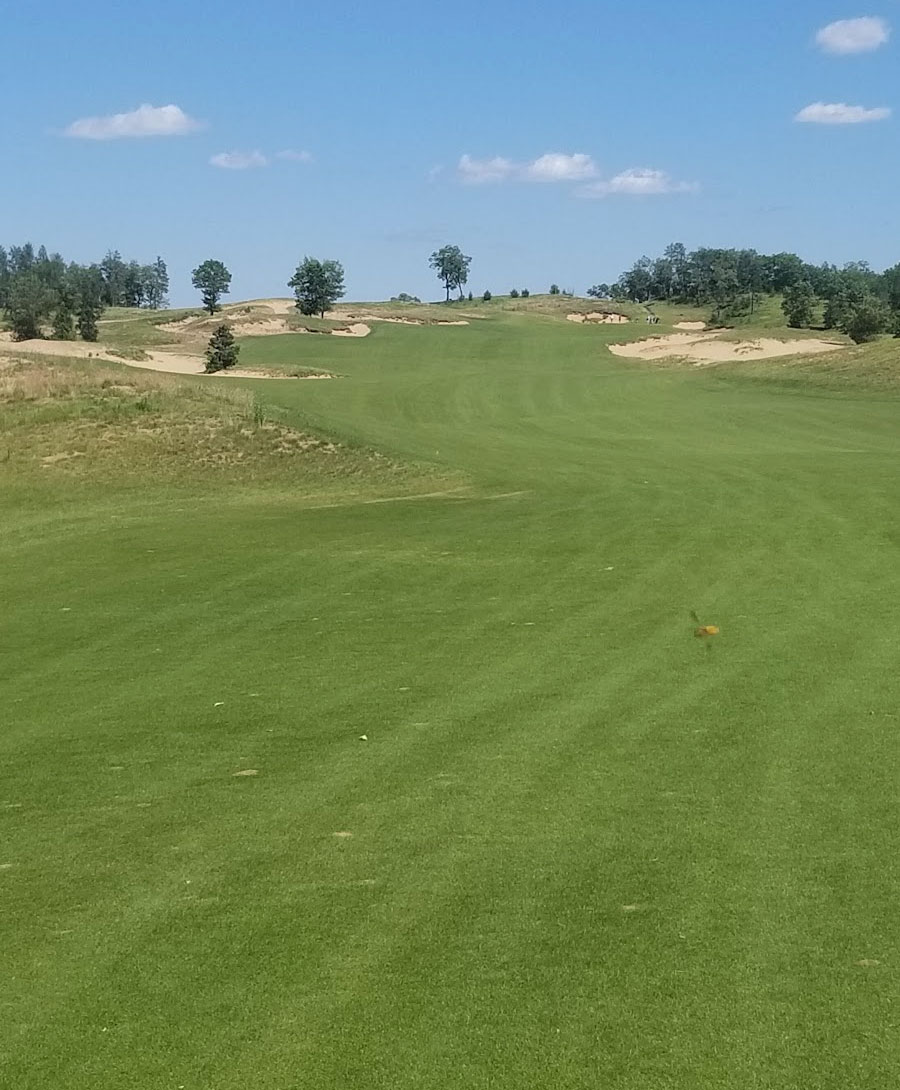
The wide driving corridor tightens considerably at this well-selected greensite benched into the dominant slope.
5th Hole: 164 yards, Par 3
A sharply downhill, short par 3 with some wind about is always a point of interest. Here, the large green is made smaller by creative slopes that fit the land. Short right leaves one some 4-6 feet below the putting surface, while an angled slope makes the back half of the green run away from the tee. Landing the ball on the green is one thing, holding the green is another proposition entirely.

From behind the 5th green, the view back towards the teebox indicates the severity of elevation change and nearby contours.
6th Hole: 445 yards, Par 4
Turning left around probably the only hidden hazard on the entire property, this hole is made by the ingenious green complex, featuring a trough in the middle-right of the green. Like an outsized version of Ross’ bathtub placed at the heroic par-5 3rd at Essex County, this feature presents a terrific strategic decision: the safe line off the tee delivers an approach angle which must negotiate more of the green’s dominant feature. Challenging the left-hand fairway bunker opens up the approach angle and options. The trough also allows for gentle or brutal pin positions.
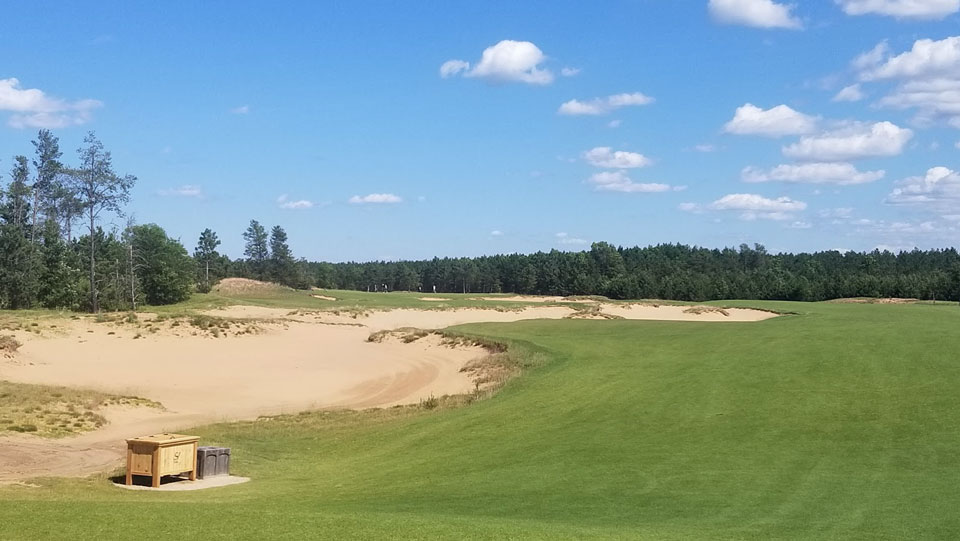
The golfer’s eye is drawn left towards the pin, right in line with a hidden bunker.
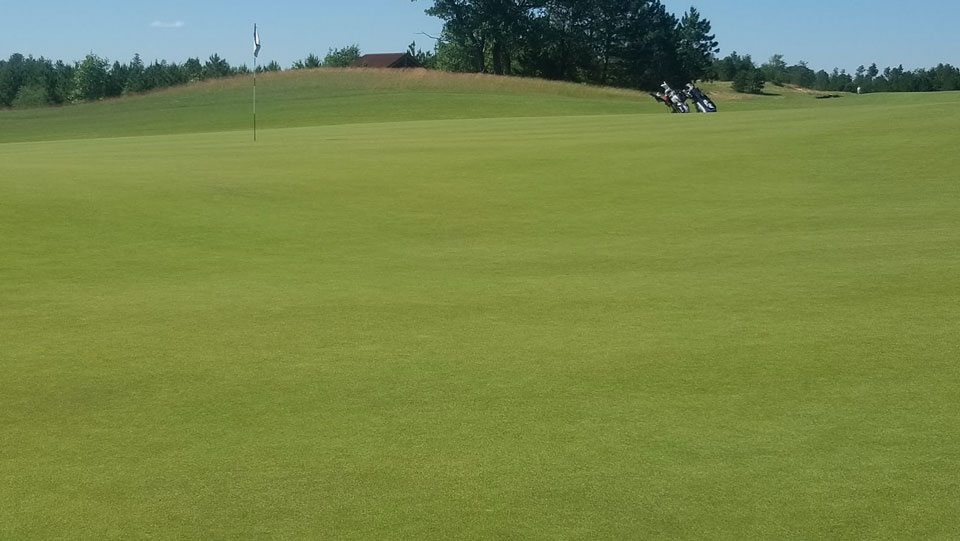
Balls tend to collect in the depression aptly placed into the middle-right of the green, dictating play off the tee.
7th Hole, 536 yards, Par 5
The hole plays uphill to a crest, then gently falls towards the green complex. Longer hitters may carry the trouble on the right, opening a terrific angle to the green. The layup is neither sleepy nor a hit-and-hope. One must attend to the angles and wind to set up for the strongly contoured green benched into the hillside.

The golfer’s options from the 7th tee are clear: challenge the trouble or aim for safety.
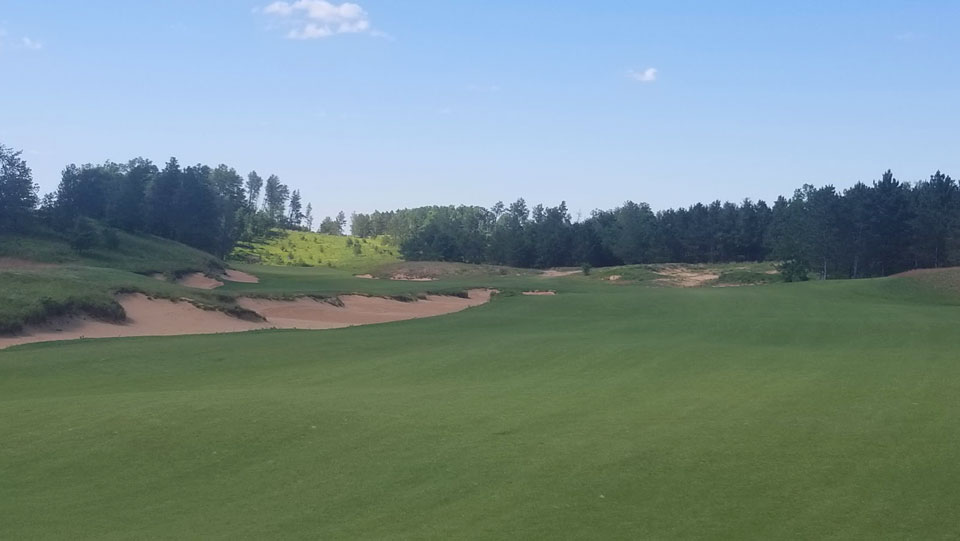
With the green complex at the left-center of this picture, one can see the complexity of the layup and the great angle afforded by challenging the trouble off the tee. The sloped green often leaves one taking one more stroke than desired.
8th Hole, 115 Yards, par 3
Befitting the short yardage, this exacting target can produce all kinds of scores. The unwieldy nature of Sand Valley’s hazards include tree roots and thick tufts of grass. Missing short right at the 8th can lead to a reasonable shot at par or some big numbers. Bailing out left leaves a downhill/downwind recovery. The interior green contours conspire with the windy hilltop site to make birdies more rare than the yardage suggests.

The 8th tee is emblematic of Sand Valley: a clear target where a well-struck shot is rewarded, while potentially big numbers await the wayward approach. A spot of luck is certainly part of the game here.
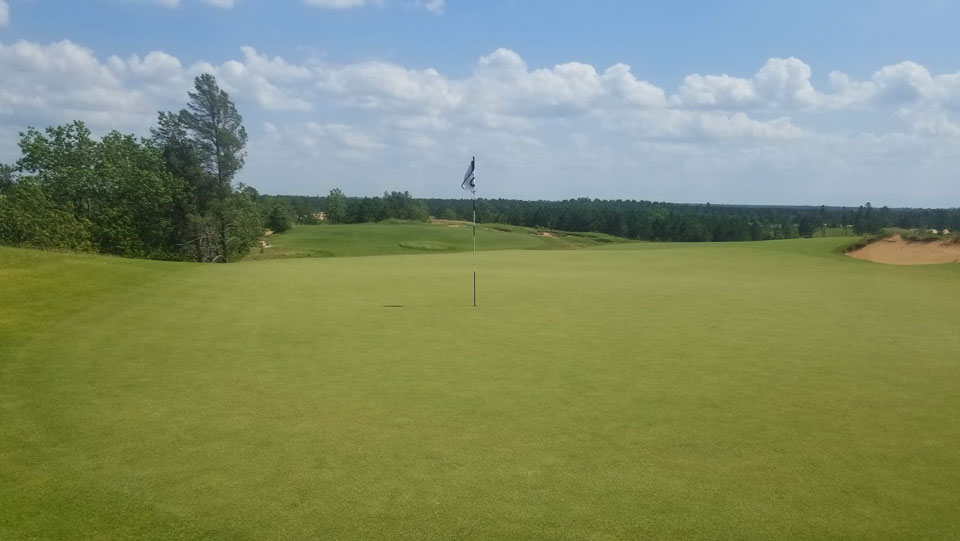
Looking back towards the 8th tee suggests a reasonably generous target, befitting an approach to a windy hilltop greensite. By this point in the proceedings, the golfer has begun to appreciate the tremendous diversity of greensites selected by Coore & Crenshaw.
9th Hole, 290 Yards, Par 4
Playing downhill and into the prevailing wind, this is another hole that often forces the golfer to take one more stroke than desired. The pin placement certainly dictates strategy for the teeball, as one must decide if the slopes fronting the green are better negotiated on the drive or with a wedge in hand.

Can a power fade get you in a good spot to negotiate the wicked fronting slopes of the 9th green? You get to decide!
10th Hole, 541 Yards, Par 5
One of three par 5’s on the back, a central hazard confronts the golfer off the tee, and thus begins the strategic calculations. Playing into the prevailing wind, the golfer who forces the drive on the high right plateau gets a nice view of the green and a simpler layup or a great angle to have a go at the green in two. This aggressive line is further rewarded by a slope front-left of the green that funnels balls towards the hole when played from the right side of the fairway.
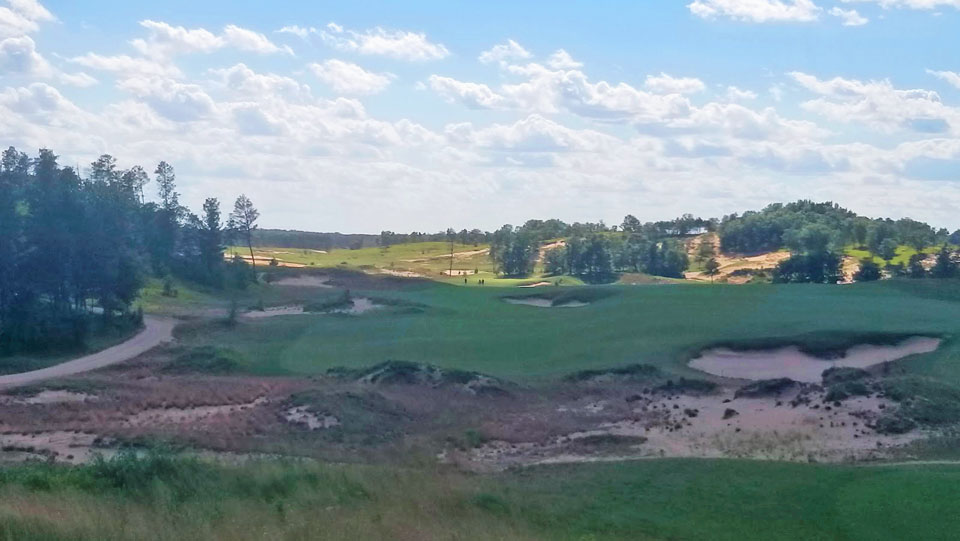
Though a straight hole in theory, the 10th presents numerous angles and decisions. Solid strikes are the order of the day as the hole faces straight into the prevailing wind.
11th hole, 387 Yards, Par 4
Turning left around an expanse of sand, the approach and green are amongst the most gentle on the course. Though not an easy hole, it’s a perfect time to cool down from the gnarly slopes of holes 7-10.

The 11th’s gentle drift left and open approach lend themselves to a tighter range of scores. That said, there’s plenty to hold the golfer’s interest.
12th Hole, 487 Yards, Par 5
The yardage belies the visual intimidation and punishing hazards on tap at the 12th. I found this to be the most uninviting of the course’s holes: an endeavor that felt forced into the terrain with a ho-hum set of green contours. With that said, options abound and can reward two or three brilliant strikes. The left hazard some 100 yards from the green should be avoided at all costs. Naturally, challenging that area provides the golfer with the best view for his or her approach.
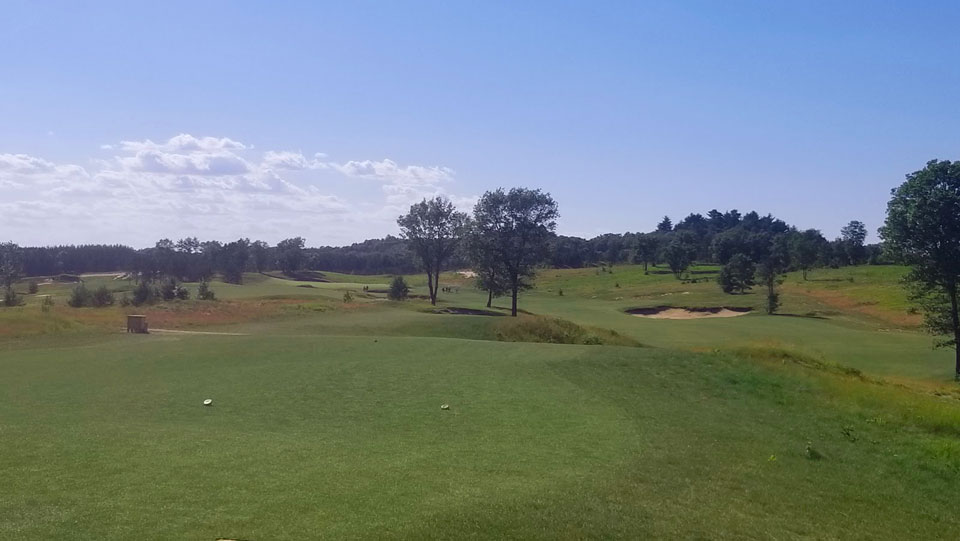
The view from the tee at #12. There is more width than appears, but any generosity quickly fades closer to the hole.
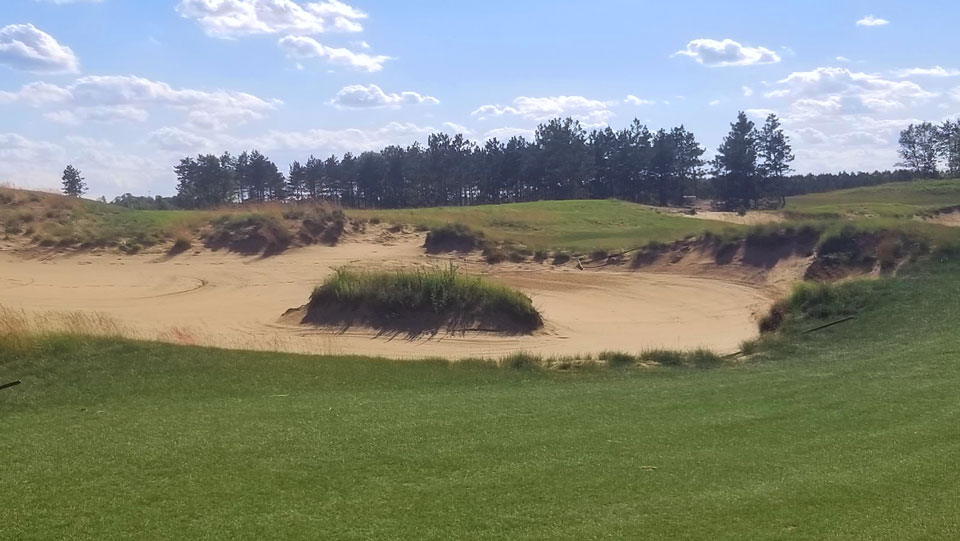
One should take care to avoid this gnarly pit left of the 12th fairway.
13th Hole, 383 Yards, Par 4
My favorite hole at Sand Valley, beginning a gloriously diverse trek into the clubhouse. A right to left sweep leaves one with an uphill approach to a horizon-ish green. With the help of the prevailing wind, a solid strike is required to hold the 13th’s green complex.
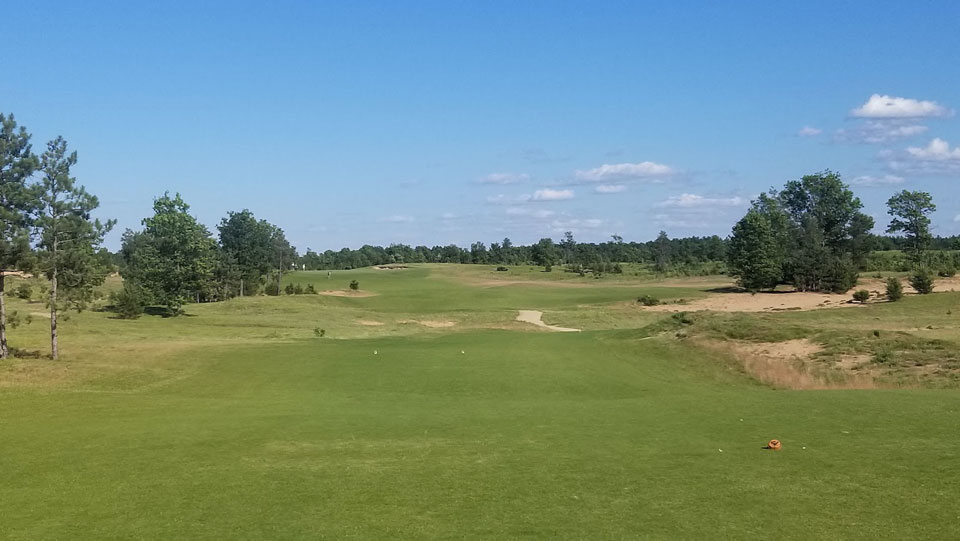
Bending left and slightly uphill, the 13th feels like it’s been a golf hole for centuries.
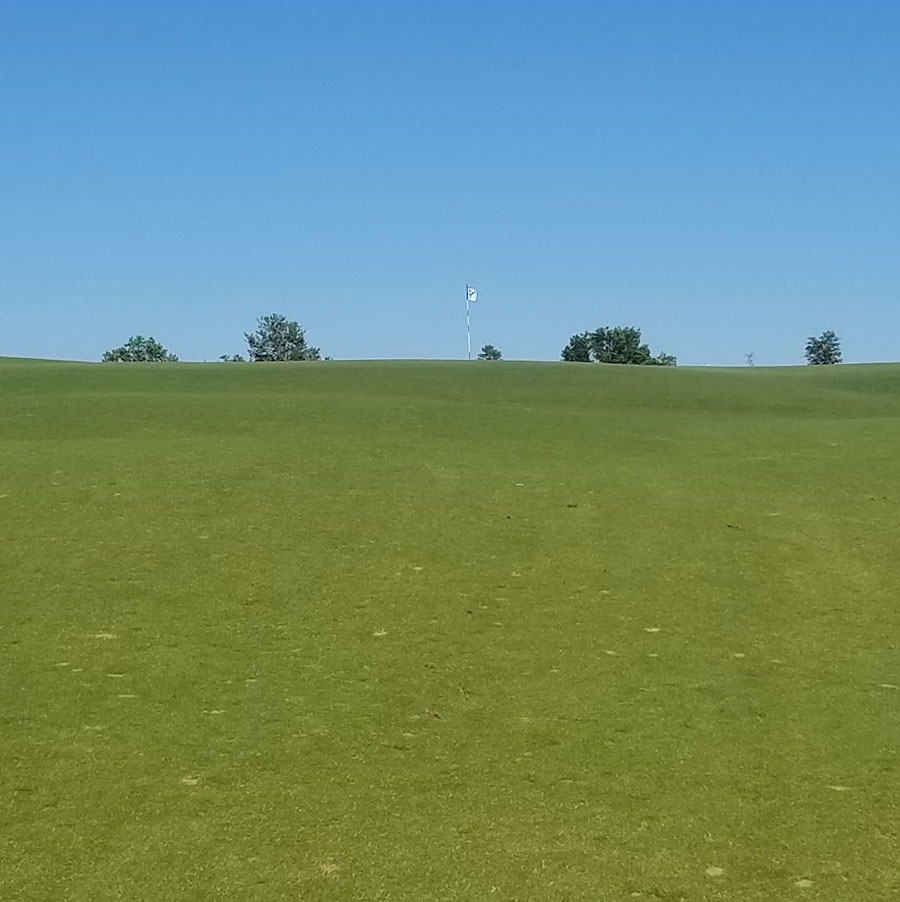
As one drives it closer to the 13th, the depth perception shrinks, sharpening the need for a crisp strike to a downwind/uphill knob.
14th Hole, 175 Yards, Par 3
Playing with the prevailing wind, one might hit the same club as at the short 8th. The 14th is considerably more conducive to scoring. Thus continues a string of finishing holes that truly seem to fit the land.
15th Hole, 392 Yards, Par 4
Golfers willing to take on the left bunker off the tee are rewarded with an approach that is less constrained by a 3 foot hump short/right of the green. Combined with the hump that greatly complicates bailout drives, the green’s back-to-front pitch adds to the drama of a tightening match.
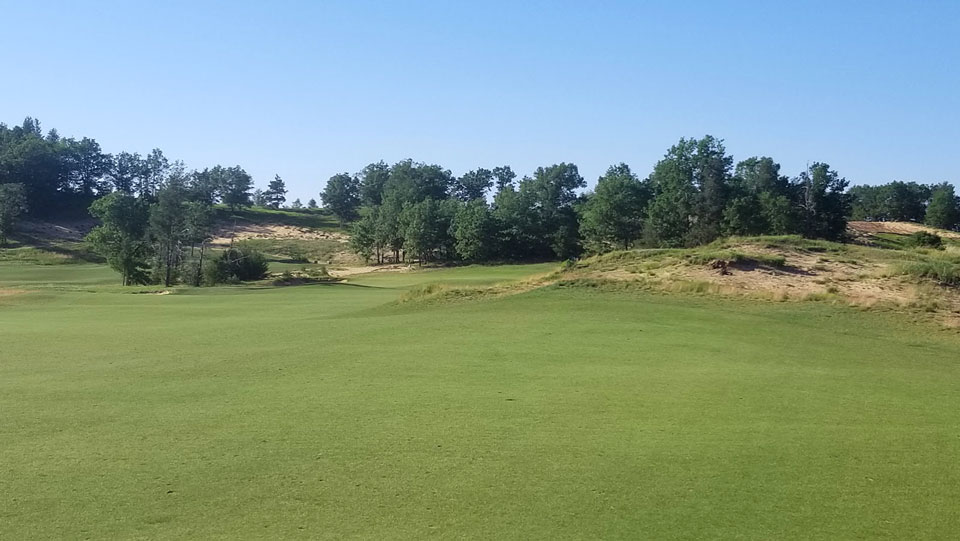
Avoiding the trouble off the tee adds to the difficulty in one’s approach at the 15th. The relatively blind shot is made more troublesome by…
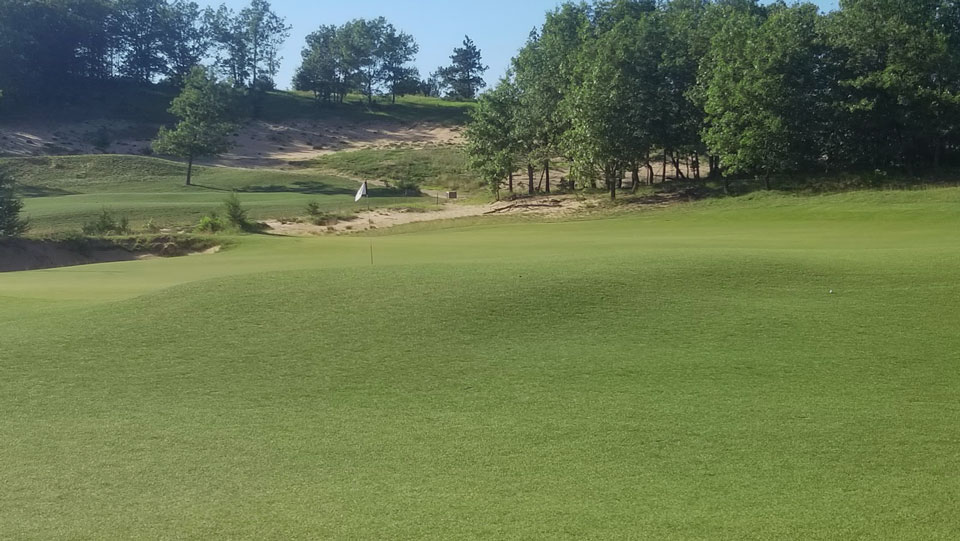
…this 3 foot hump fronting the right ⅔ of the green. Options abound. When coupled with the steep pitch of the green, a match could turn on this seemingly innocuous hole.
16th Hole, 429 Yards, Par 4
A true fairway bunker again offers the golfer to challenge left or bail right off the tee. The hole is further defined by the wicked left-to-right sideboard at the green. I found the sideboard in need of softening, as trying to use it only spit the ball off the back of the green. Over time this may be massaged to provide a genuine reward for challenging the fairway bunker off the tee.
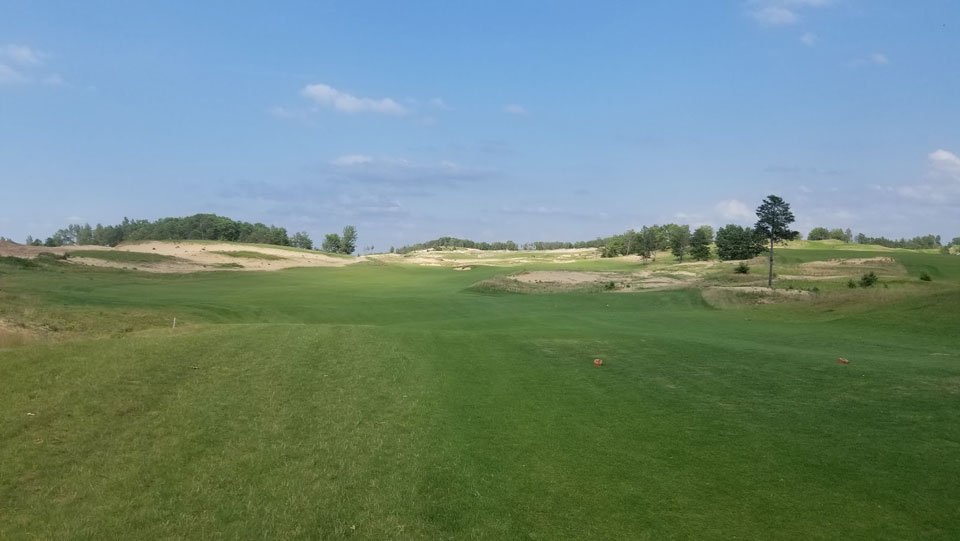
The fairway bunker is in the dead center of this picture. Finding the leftward alley of the fairway at the 16th allows one to skip some of, but certainly not all, the severity at the 16th green…
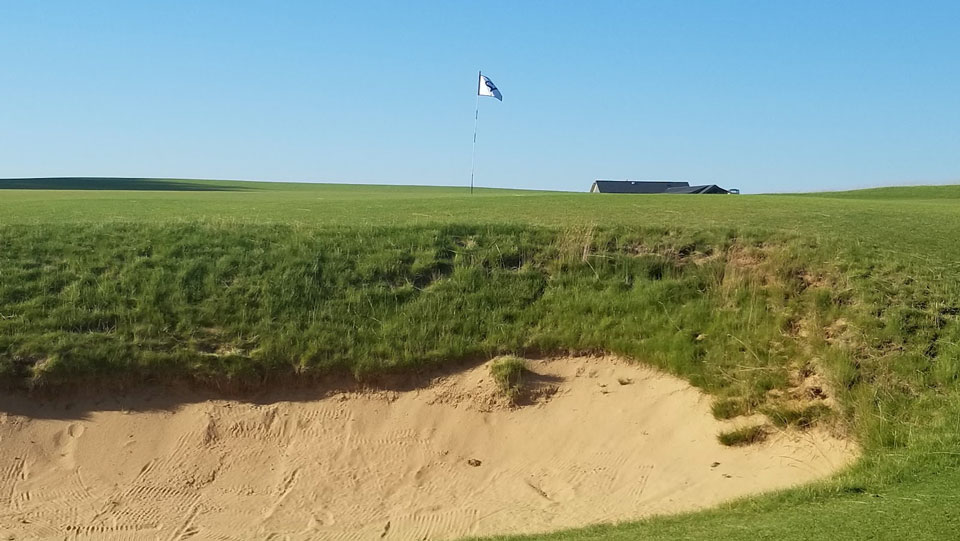
…but plenty of trouble still remains for a short-right miss!
17th Hole, 215 Yards, Par 3
An all-world hole that plays, or at least feels, like a punchbowl into the prevailing wind. Appropriate for the difficulty of the approach, the green is large but by no means gentle. In three rounds, I saw scores range from 2 to 6: a true match play gem.
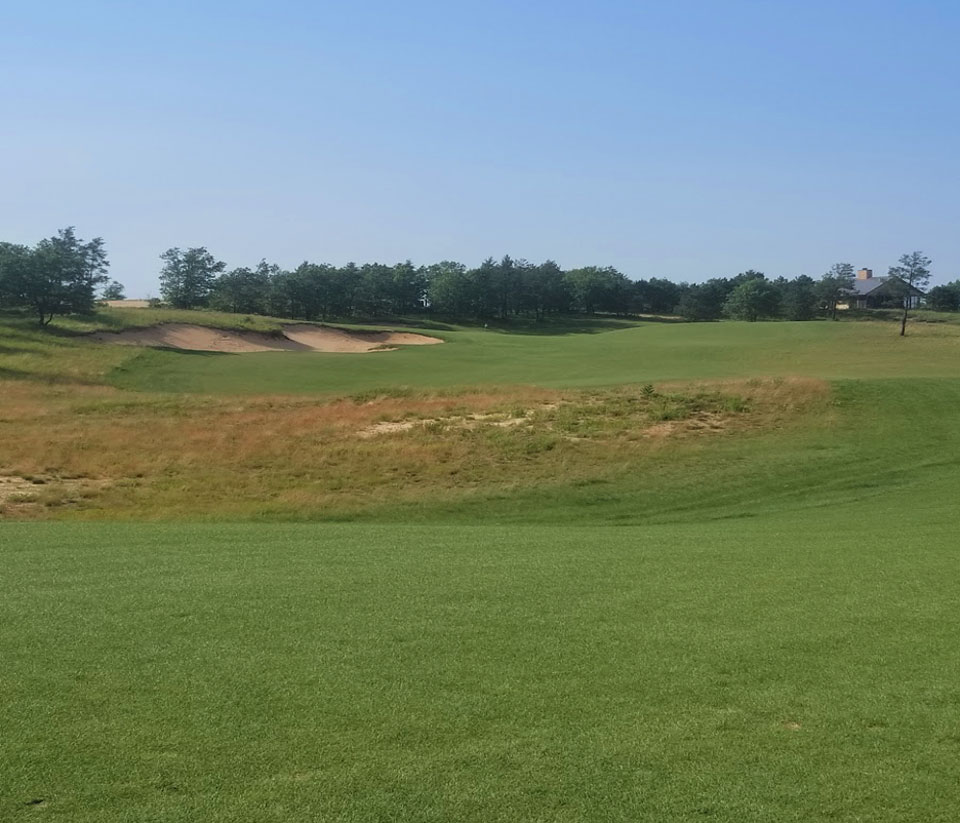
Though perhaps not a true punchbowl, the 17th has some of the characteristics. Playing 230+ yards, one may need all the width and slopes in order to find…
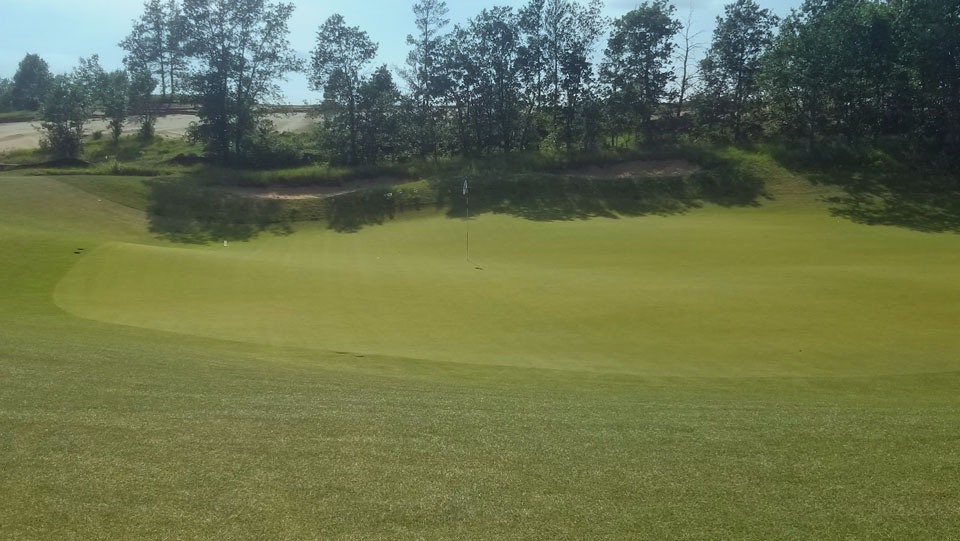
…a boldly contoured green that will leave its mark on a tight match.
18th Hole, 507 Yards, Par 5
A strategic finish awaits the golfer on this uphill/downwind par 5. The expanse of sand right of the fairway is a sure bogey or worse. A back-right pin placement may appear totally inaccessible, but the green’s ingeniously playable left-right sideboards allow for numerous options and scores. In contrast, the seemingly easy front hole locations can be difficult to hold. This massive green and its options for scoring of all types is emblematic of the entire experience on offer at Sand Valley.

Options off the tee…
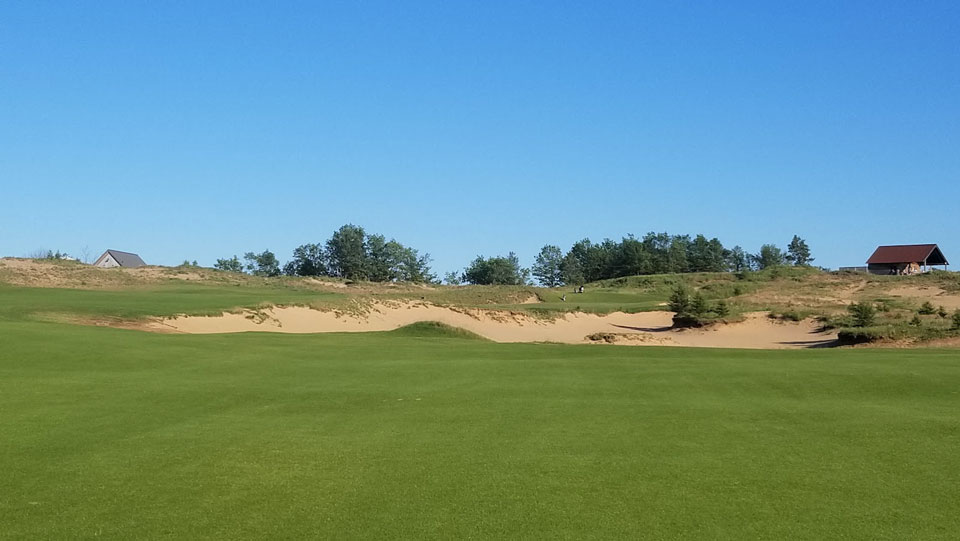
…hopefully allow one to avoid this pit…
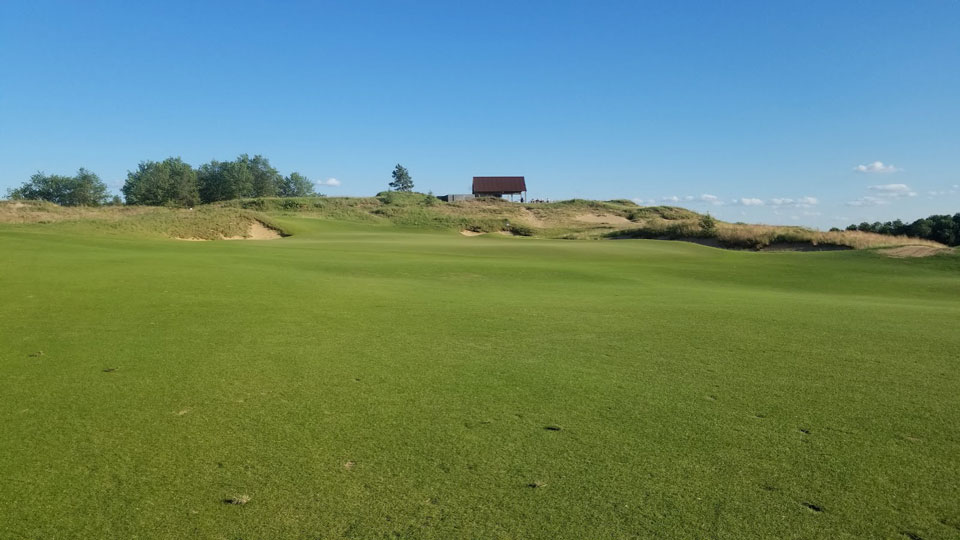
…and even afford the golfer a crack at this seemingly impossible pin. (The pin is located below the right ⅓ of the shed, some 40 yards beyond the false front.)
Mention must be made of the course’s minor, but noticeable, detractions which may place Sand Valley a slot below the legendary design duo’s finest efforts. For whatever reason, the vast majority of holes at Sandy Valley flow right-to-left. One may say that a 250 yard draw off the tee is always an advantage, but here it is unnecessarily outsized. Though Sand Valley is a special place to play, my opinion is that there was enough room and terrain to play with such that this pervasive pattern could be attenuated. Perhaps the design was attending to a golf resort’s tendency to have less skilled slicers be accommodated by bailouts, but Sand Valley is so clearly a golf-lovers resort that I don’t see the need to cater to this type of player.
More importantly, the depth of sand and lack of rakes practically guarantees an overflowing number of fried eggs and balls in footprints. For example, I had a well struck 4-wood plug in the flat part of a bunker. The expanse of sand to the right of 18 is simply untenable as a hazard for a course that might get 150+ rounds in a day. One might have to rake 75 yards of sand to get to their ball and back, meaning it won’t happen. A potential solution would be to install wood plank walkways throughout some of the larger hazards and include more rakes for course maintenance. In its current iteration, the hazards are simply littered with deep footprints. Worth noting is that these issues are not present at Mammoth Dunes, where the sand and hazards are in much better condition.
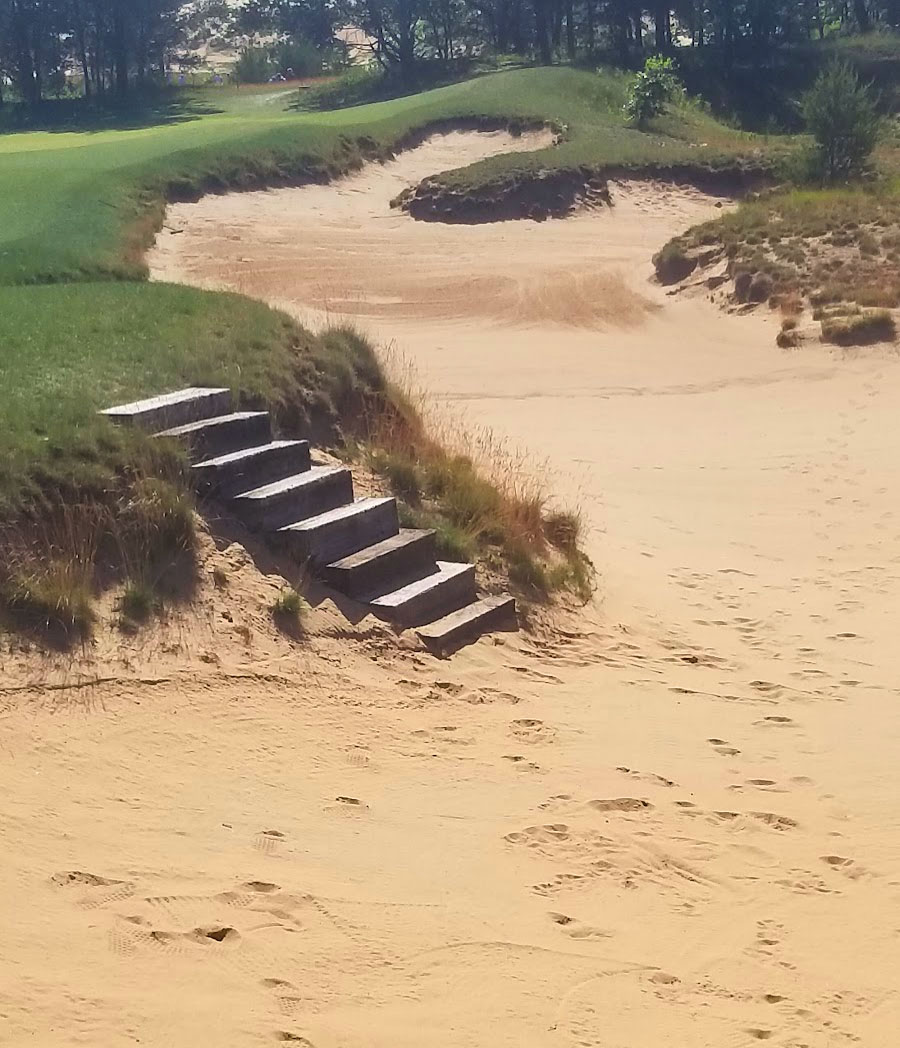
As golfers tire of the massive hazards with few available rakes and steps, even the sand very close to the stairs and rakes becomes littered with footprints. Might some wood plank paths even things out a bit?
My opinion is that the resort’s two regulation courses are mirror images of Bandon Dunes, where Bandon Trails feels a notch better than Kidd’s splendid effort. In the case of Sand Valley, I think Kidd’s Mammoth Dunes got the better of Coore/Crenshaw in terms of diversity, flow, and overall appeal. But make no mistake: Sand Valley is a true delight with incomparable turf conditions. Also, Coore/Crenshaw delivered an absolutely divine, must-play short course: The Sandbox. Their stellar 17 holes, sporting a Redan, double plateau, Road, and all kinds of originals, have to be as intriguing as any version in the world. You may never want to leave.
This humble effort is dedicated to Howard “Jack” Varley, who inspired many to enjoy the great game to its fullest.
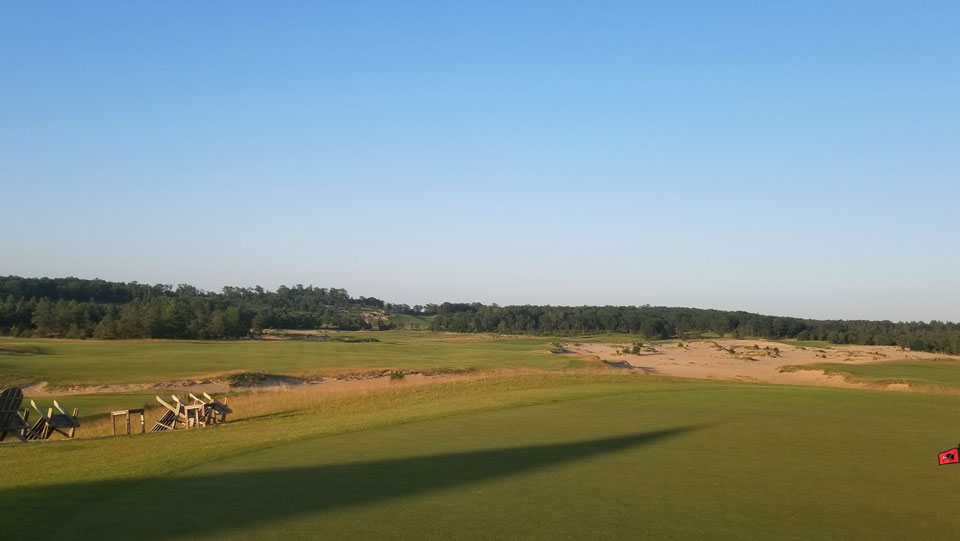
As one unwinds from 36 (or 53!) holes, basking in the laid back vibe of Sand Valley screams of pure golf in the heart of Wisconsin.
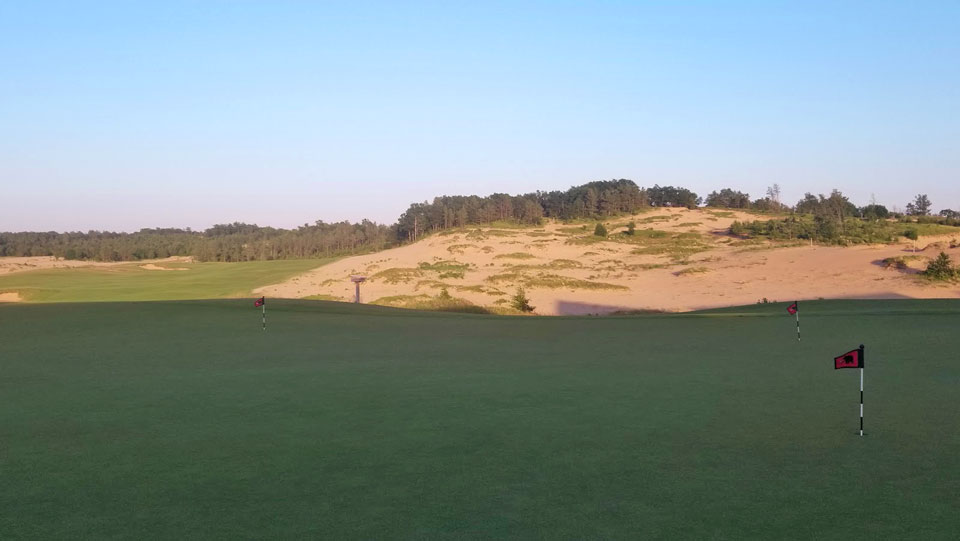
The End







